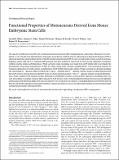Functional properties of motoneurons derived from mouse embryonic stem cells
Abstract
The capacity of embryonic stem (ES) cells to form functional motoneurons (MNs) and appropriate connections with muscle was investigated in vitro. ES cells were obtained from a transgenic mouse line in which the gene for enhanced green fluorescent protein (eGFP) is expressed under the control of the promotor of the MN specific homeobox gene Hb9. ES cells were exposed to retinoic acid ( RA) and sonic hedgehog agonist (Hh-Ag1.3) to stimulate differentiation into MNs marked by expression of eGFP and the cholinergic transmitter synthetic enzyme choline acetyltransferase. Whole-cell patch-clamp recordings were made from eGFP-labeled cells to investigate the development of functional characteristics of MNs. In voltage-clamp mode, currents, including EPSCs, were recorded in response to exogenous applications of GABA, glycine, and glutamate. EGFP-labeled neurons also express voltage-activated ion channels including fast-inactivating Na+ channels, delayed rectifier and I-A-type K+ channels, and Ca2+ channels. Current-clamp recordings demonstrated that eGFP-positive neurons generate repetitive trains of action potentials and that L-type Ca2+ channels mediate sustained depolarizations. When cocultured with a muscle cell line, clustering of acetylcholine receptors on muscle fibers adjacent to developing axons was seen. Intracellular recordings of muscle fibers adjacent to eGFP-positive axons revealed endplate potentials that increased in amplitude and frequency after glutamate application and were sensitive to TTX and curare. In summary, our findings demonstrate that MNs derived from ES cells develop appropriate transmitter receptors, intrinsic properties necessary for appropriate patterns of action potential firing and functional synapses with muscle fibers.
Citation
Miles , G B , Yohn , D C , Wichterle , H , Jessell , T M , Rafuse , V F & Brownstone , R M 2004 , ' Functional properties of motoneurons derived from mouse embryonic stem cells ' , The Journal of Neuroscience , vol. 24 , no. 36 , pp. 7848-7858 . https://doi.org/10.1523/JNEUROSCI.1972-04.2004
Publication
The Journal of Neuroscience
Status
Peer reviewed
ISSN
0270-6474Type
Journal article
Collections
Items in the St Andrews Research Repository are protected by copyright, with all rights reserved, unless otherwise indicated.

